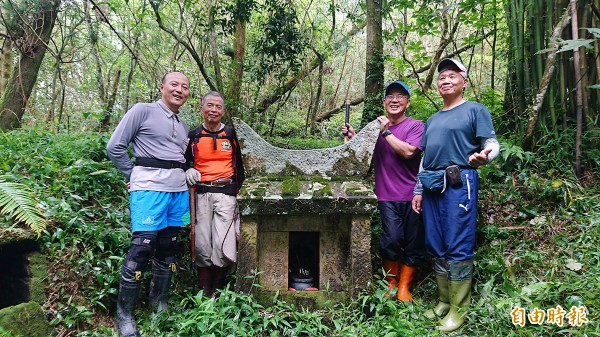《TAIPEI TIMES》 Project documents shrines for the first time

Architect and author Liu Hsien-tsung, left, hiking guide Chiang Chi-hsiang, right, and others pose next to one of the Tudigong shrines they found along the Danlan Old Trail in New Taipei City in an undated photograph. Photo courtesy of Liu Hsien-tsung
By Yeh Kuan-yu and Jonathan Chin / Staff reporter, with staff writer
Architect and author Liu Hsien-tsung (劉憲宗) said his study of small Tudigong (土地公, Earth God) shrines along Danlan Old Trail (淡蘭古道) is the first systematic work done on the subject in the nation.
The first volume of Liu’s research, entitled A Survey of Small Tudigong Shrines on the Old Mountain Paths in New Taipei City: The Shuangsi Area (新北市山林古道之小土地公廟調查與測量: 雙溪地區), was published in November last year by the Our Lady of Providence Girls’ High School Cultural Foundation.
The small shrines Liu’s research refers to are the stone-carved temples for Tudigong, which are between 1m and 1.5m tall. Tudigong are a class of local deities that are tied to the land. Their worship is still widely practiced in Taiwan.
Two centuries ago, Han Chinese pioneers began to settle the hinterlands of Taiwan. This included a wave of migration that originated in the Tamsui Subprefecture (淡水) and moved toward the Kebalan Subprefecture (噶瑪蘭), known today as Yilan County, Liu said.
As the Han Chinese built more settlements, they developed a system of trails to link their villages together, which later became known as the Danlan Old Trail, he said.
During this period, as many as 250 little stone Tudigong shrines were built in the region, Liu said, adding that this number accounts for a quarter of such shrines in Taiwan.
The extraordinary density of shrines along the Danlan trail is a testament to the religious importance of the Tudigong to the early Han Chinese settlers, he said.
“The Tudigong shrines are the soul of Danlan Old Trail and they are evidence of our forerunners’ way of life and cultural values,” he added.
When the Han Chinese created settlements in Taiwan, their first priority was finding sources of water, which they developed for their terraced farms or rice paddies, he said.
However, once the pioneers’ material needs were secure, they had to meet their spiritual needs, Liu said.
“Banditry and armed clashes between communities were rife, and there was the ever-present threat of Aborigine raiding parties,” he said. “Villagers sought blessings and found spiritual solace at the Tudigong shrines.”
Due to its relatively late settlement, New Taipei City’s Shuangsi District (雙溪) boasts nearly 90 small Tudigong shrines, Liu said.
His research is focused on cataloging, measuring and recording the distinctive features of small Tudigong shrines, he said, adding that it includes 47 of Shuangsi’s shrines.
Hiking guide Chiang Chi-hsiang (江啟祥) was a major contributor to the research, Liu said.
Chiang said he has explored more than 90 percent of the old paths in the mountains surrounding Taipei and New Taipei City over the past three decades.
He spent hours with Liu, cutting through thorns and tall grass in search of little shrines, Chiang said, adding that the year-long project took more than 90 expeditions along the old trail to complete.
“Once, we found just one shrine after an entire day of hiking. To find it, we ended up asking for directions from an 80-year-old village elder. However, sometimes, a shrine would just appear to us as if it wanted us to find it,” Chiang said.
Most shrines are built near big rocks or under a great tree that is located at either the head or tail-end of a village, or on the saddle of a ridge, he said.
Usually the shrines face a body of water, so that the Tudigong can symbolically guard a village’s water and wealth, he said, adding that when they could not spot a shrine, they often headed to the nearest body of water.
Shuangsi District’s Hubaotan Old Trail (虎豹潭古道) is a branch of the Danlan trails that passes by many old shrines and its entrance has a parking lot for visitors, Chiang said.
There are many old Tudigong shrines in New Taipei City that are not well-documented and they risk being damaged or becoming overgrown, Liu said, adding that the city government has been working with the Taiwan Thousand Miles Trail Association to preserve the old trails and the shrines.
新聞來源:TAIPEI TIMES

Hiking group members walk along a trail in New Taipei City in an undated photograph provided by architect and author Liu Hsien-tsung, who has been documenting Tudigong shrines along the Danlan Old Trail. Photo courtesy of Liu Hsien-tsung















